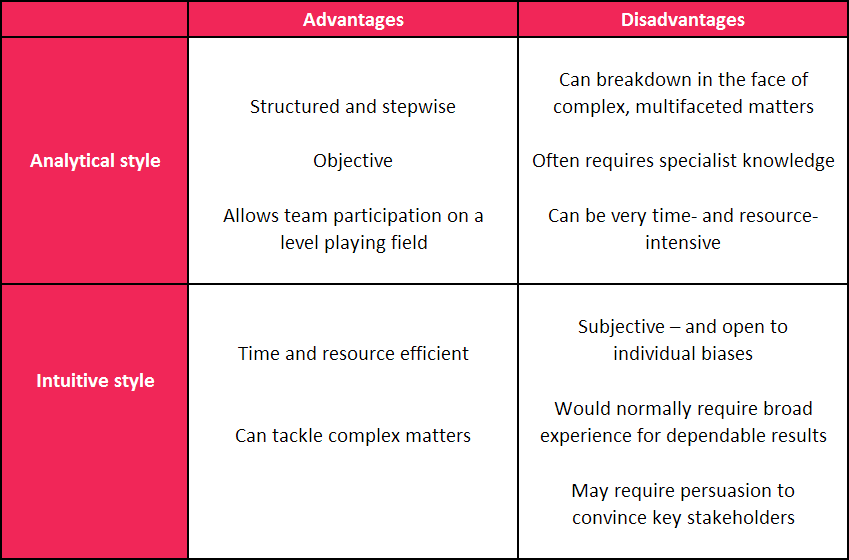 There are at least two modes styles of thinking that, in my experience, managers appear to follow in developing their strategy, whether business or technology strategy. Some mangers prefer an intuitive style of strategic thinking, while others favour a more analytical style.
There are at least two modes styles of thinking that, in my experience, managers appear to follow in developing their strategy, whether business or technology strategy. Some mangers prefer an intuitive style of strategic thinking, while others favour a more analytical style.
Before getting into what I mean by intuitive or analytical (although this is likely to be already obvious to you) it is important to point out that there is no clear winner between the two. Individually, each one has contexts and situations that it is particularly suitable for. It is also important to note that people have different personality ‘make-ups’ (as Myers-Briggs[1] will suggest), and some people are naturally analytical while others are intuitive. As such, to elevate one mode of thinking over the other is, perhaps, to declare a significant fraction of human society better than another – which I am never keen on.
Nevertheless, there are strengths and weaknesses associated with both styles of thinking and it is important to identify these. By knowing and combining these strengths, especially where the combination helps overcome weaknesses of individual styles, managers may begin to find for themselves, more effective ‘sweet spots’ between analytical and intuitive thinking for addressing strategic issues.
Analytical vs. Intuitive
The analytical style of thinking is step-wise and logical. It usually attempts to break a problem or issue into its constituent parts both to understand and to address or solve it. It is usually very methods-driven, following thought-through (and sometime research-derived) models and frameworks. Examples of these are the real options analysis for planning technology investments, and business model canvas, used during new business development).
On the other hand, the intuitive style of thinking is driven more by gut-feel and confidence derived from experience. It does not follow a prescribed set of analytical steps, but draws on observed indicators and trends from the internal and external organisation environment to reach strategic decisions. Since specific explicitly available formulae are not followed, it relies on the individual’s ability developing their own internal modes of making sense of strategic issues.
There are advantages attributable to these different styles of thinking. For instance, an analytical approach to a certain matter will normally be open and allow objective contribution of multiple individuals allowing them to work together based on a commonly understood model or framework. An intuitive approach is normally fast and efficient. It relies on the mental and experiential capacity to read meanings into observed patterns and derive solutions very quickly.
Of course there are flip sides to these advantages, and the downsides to each approach are often easy to observe. When faced with complex problems, analytical approaches often breakdown, unable to cope with the range and levels of variables. The reliance on models also means that it requires specialist knowledge, e.g. the understanding and use of the Black-Scholes model for real options valuation.
Intuitive approaches are very individual, and rely on tacit knowledge that is not often easy to share. Bringing others on board to agree on a decision often would rely on the power of persuasion, and sometimes the making links between influencing factors that stakeholders may find tenuous and difficult to accept. Decisions can very easily be seen as subjective or, worse, political in nature.

A sweet middle point? – some ideas
Over the years in leading and participating strategy meetings and workshops, I have noticed individuals’ natural preference for one style of thinking over the other. Some would like to find a way to break the problem down, understanding and solve each component before aggregating the solutions – the analytical thinkers, while others prefer to start with an overall vision and help individual issues ‘fall in place’ as we go along – intuitive thinking. It is not entirely uncommon that disagreements would ensue over the ‘better’ approach before one party eventually begrudgingly bends to the will of the other.
It is often best, if possible, to find a middle point, at which people at the extremes of the analytical-intuitive spectrum are still willing to engage. In doing this, I have found that it is important to understand that there are multiple aspects to developing a strategy (e.g. visioning, identifying and understanding market/industry trends and drivers, understanding and assessing core resources and competences, etc.), and to identify where an analytical or intuitive approach is better given the context. Often a mix of analytical and intuitive techniques would result and deliver a more rounded approach to strategy. For example, one can use intuitive approaches to formulate a vision and apply more analytical techniques to assess organisational competences. Another thing to do is (again, where possible) to allocate aspects of the process to matching personality types, so people can contribute through the approach they are more comfortable with.
One other thing I have found very useful, especially in strategy meetings and workshops is the use of strategy templates that blend intuitive and analytical styles of thinking. Such templates, usually customised to the specific strategic issue the organisation is looking to address, have quite often found an appropriate level of analytical rigour that can be delivered in a time- and resource-efficient manner. They bring in the visual element to strategy that many can relate to and work with, and facilitate consensus among participants.
Imoh Ilevbare
[1] Myers-Briggs Type Indicator – provides some indication of how people perceive the world and reach decisions.

